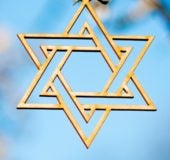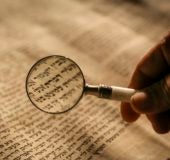CHAPTER TWOThe Essence of Prayer Prayer is the salient expression of religious emotion in man and of his relationship with his Creator. There are, of course, many other forms by which people may express their religious feelings—from those fixed ceremonial rites that in themselves constitute a religious ritual, to those acts which man performs in order to obey the will of God, or from which he may refrain because they negate the Creator’s will and command.
While these aspects are to be found in every person possessing religious feeling, they are to be found even more so in the Jew, whose life is filled with positive and negative commandments, traditions and customs, and Jewish ways of expression and thought.
Yet there are various influences that are prone to obscure or conceal the inherent purpose of those acts that a person might perform in order to express a relationship with God. Habit and routine may cause a person to cease being aware of the reason for the performance of a given action. It often happens that a person living in a society that shares his faith and behaves in a similar fashion will perform these acts because they seem the normal mode of behavior, without attention to their actual content.
Even when a person performs a ritual ceremony, there is no assurance that the meaning of this performance will be fully realized, as every act involves an external, technical aspect. By punctilious insistence upon performing it in a precise and particular manner, and in assuring that all the objects required are in proper condition, a person is liable to forget its main purpose.
By contrast, prayer is a direct and unequivocal act of relating to God. In whatever way it is performed, and in whatever manner it is uttered, prayer is essentially one thing: an explicit addressing by the human “I” to the Divine “Thou.” In the most essential sense, prayer is direct speech, in which man confronts and addresses his Creator.
Such speech may be of many kinds: request, supplication, thanksgiving, complaint, or even simple conversation. All these can be found in prayer, and each one of them can be expressed by personal, individual prayer. The prayers that may be found in the books of the Bible—particularly in the Book of Psalms, which is basically a compendium of individual and public prayers—represent all of the kinds and varieties of prayer with which the individual or public may address God the Creator. The wide range of prayers and benedictions found in the Siddur likewise include the entire spectrum of ways in which a man may address his Maker.
Many prayers are requests or pleas in which man addresses God and asks for something—be it life, health, or success, deliverance from disaster or from poverty. Man may appeal on behalf of himself or for others, whether near and dear or distant acquaintances. On the other hand, there may be requests of an entirely different sort, in which a person asks God to consider the shame he had suffered, or voices his desire to be avenged, to have his enemies punished.
There are still other prayers that are a way of saying “Thank you,” whether in general—for all the good things in life, or for the existence of something beautiful or pleasurable—or for some personal, private matter—recovery from illness, deliverance from danger, or in acknowledgement of some special event.
On the other hand, there may be prayer that is an expression of questioning, of wonder, or even of complaint, such as the bold words of criticism uttered by Abraham: “Far be it from You to do so, to slay the righteous with the wicked. . . . Shall not the Judge of all the earth do right?” (Genesis 18:25); or the complaint that also indicated supplication and submission: “Righteous are You, O Lord, when I complain to You; yet I would plead my case before You. Wherefore does the way of the wicked prosper?” (Jeremiah 12:1).
There are yet other prayers that have no clear, definite form of address, but are merely a kind of conversation or outpouring of the heart before God. At times, this confession is a declaration of love and yearning such as “My soul thirsts for You, my flesh longs for You” (Psalm 63:1); at others, it expresses a sense of distance in which the person bares his heart before God, asking nothing, yet expressing his grief at his material or spiritual loss.
On yet other occasions, a person may wish to “tell” God about his good deeds, and to say with a sense of satisfaction, “Remember this, O my Lord, for my good” (Nehemiah 5:19), or may wish to confess his sins, both overt and covert. All these types, and many others, may be expressed in personal prayer, and are thus to be found in the Siddur, formulated as it is or both personal and public use.
This aspect of prayer—of direct speech addressed to God—is essentially very intimate in character. Not only when a person is alone in the darkness of night, pouring out heart and soul, but even when standing in the midst of a large congregation, with everyone reciting the same words aloud, a close, intimate relationship with God is being expressed. This address in the form of conversation, of direct speech of the human “I” to the Divine “Thou,” even when expressed by the entire congregation, is based on the simple assumption that such dialogue is possible.
But whether plea or praise, prayer is always speech addressed to God, and such speech is only possible when a person knows that “Verily God has heard me and attended to the voice of my prayer” (Psalm 66:19). This realization that “You hear the prayer of every mouth” is what directs man to pray and to confide in God all those secret, personal matters—needs, anxieties, requests, and heartfelt desires.
But in order to pray in this manner, to “pour out his complaint before the Lord” (Psalm 102:1), one needs to feel a sense of intimate closeness to God, as “Our Merciful Father.” The child standing before his father feels he can tell him everything in his heart: to plead, to complain, to thank, or to simply tell him about things.
At every such moment of baring the heart, in times of distress or joy, prayer takes place with the same feeling of affinity as that reflected in one of the
Piyyutim recited during the Days of Awe, “For we are Your sons, and you are our Father” or, in a more profound and even mystical manner, “We are Your beloved and You our Lover.”
But in contrast to this approach to prayer, there is another aspect, deriving from a totally different point of view. There is a different mode of relationship to God—that expressed by the prophet: “For who is this that has ventured to approach Me, says the Lord” (Jeremiah 30:21); or, expressed differently, “For I am a great King, says the Lord of Hosts, and My Name is awesome before the nations” Malachi 1:14).
This sense of awed reverence, of standing before the exalted Divinity, is rooted in the recognition of the distance separating Man from God, As Maimonides says, “When he [i.e. man] considers such matters as they really are, he immediately retreats in fear, knowing he is a small, lowly creature standing light-mindedly before the Omniscient God.”
Once a person adopts such a point of view, intimate conversation is impossible, and prayer acquires an entirely different character. Confronted by “the Great King,” one can only offer the rituals of sacred service. That is, given such a conception, prayer itself is no longer a spontaneous form of speech, but becomes a kind of ritual sacrificial act. When prayer assumes this aspect of holy service, each part fulfills a particular function in the ritual, and every word fits into its context in a precise and specified manner. This ritual requires that one wear special clothing, and every movement of the body has its own meaning and significance. Prayer then becomes a kind of royal audience, composed entirely of ceremonial grandeur, each word and phrase having its specific place within the ceremony.
Such a ceremony may be held in the “Royal Temple,” a site symbolizing the dwelling place of the King of the Universe. Yet by the same token it may be held anywhere, as there is no single “place” for the Omnipresent God, and hence no need for any special building. Unlike prayer, the “temple” or “palace” has a physical reality—but in essence entry to them is identical. When praying, one is as if standing at the gates of a spiritual temple, and every step is taken—in the spiritual sense—is a passage from one chamber into another, until one ultimately stands before the Presence of the Almighty.
Such a feeling is not one of fear, but essentially of awe, of the sense of standing before the sublime, “For God is in heaven and you upon earth, therefore let your words be few” (Ecclesiastes 5:1). The emphasis here is not on the fewness of one’s words, but on the consciousness of the qualitative distance between Man and God. When such a realization occurs, man cannot simply say whatever he pleases. Every word uttered must be weighted and counted, and every gesture must be considered and measured. Such feelings need not imply fear or melancholy, on the contrary: they are always accompanied by a sense of privilege that “the King has brought me into His chambers” (Song of Songs 1:4). But in any event, and whatever the content of prayer, it is always a ceremonial occasion, of worship and ritual.
Both these conceptions—God as father, close and intimate, and God as exalted and majestic Being—which seem to be at opposing poles or religious experience, are united in the world of Judaism. Indeed, their combined presence is in itself a fundamental principle in the Jewish worldview. As the poet says, “Further than any distance and nearer than any nearness,” or, “Wherever I find You, You are concealed and evanescent, and wherever I do not find You, Your Glory fills the earth.”
This dual conception, known in philosophy as the combination of the transcendental and immanent view of the Divine, and referred to in the Kabbalah as the tension between the aspects of God as “surrounding all worlds: and “permeating all worlds,” is an essential element of the inner truth of Judaism, and constitutes a central issue in every work of Jewish thought. Any examination of Jewish faith relates to this issue, either directly or indirectly.
The kabbalistic appellation of God—“the Infinite, blesses be He”—in itself reflects this double aspect of the Divine, combining an abstract, distancing term alongside one of nearness and human concern.
But such ideas are not confined to the theoretical concerns of usages and philosophers, but are expressed in the very nature of prayer itself. In fact, prayer can only be understood as combining both of these conceptions. Already in one of the most ancient prayers, we find the opening phrase conveying this attitude, “Our Father, Our King”
(Avinu Malkenu). The inner tension of our relationship toward the Creator—“whether as sons or as servants”—runs through the entire order of prayer services. Sometimes one prayer may express the sense of standing before an exalted Being, while the very next prayer may be a petulant complaint uttered in extreme intimacy.
Sometimes the formulation of one benediction, such as that of
Hashkivenu in the Sephardic rite, may delicately interweave both conceptions, “Lay us down, our Father, to sleep . . . and raise us up, O King, to life and to peace.” When a person goes to sleep, it is as if he reposes in the arms of his Father, while when he arises from bed he is ready to serve and obey the King, his Master.
These two formulations also find expression in the rabbinic dispute as to whether “Prayer was instituted by the Patriarchs” or “Prayer was instituted corresponding to the sacrifices” (
Berakhot 26b). This inner tension is also reflected in the prayers of various communities and congregations: some tend to stress the ritualistic aspect, while in others, the more personal, private element is predominant. Yet everywhere and for everyone, both aspects always coexist.
This dial view is essentially based on the very mystery that surrounds our attitude, understanding, and perception of the Master of the Universe
(Adon Olan), who is at the same time “the Merciful Father”
(Av ha-Rahaman). Our Siddur encompasses and combines together both these appellations of God as a whole, thereby allowing us to alternate in word and thought from one conception to the other.
Copyright © 2002 by Rabbi Adin Steinsaltz. All rights reserved. No part of this excerpt may be reproduced or reprinted without permission in writing from the publisher.





